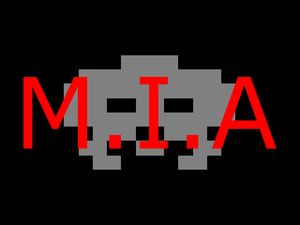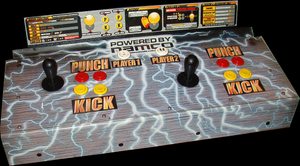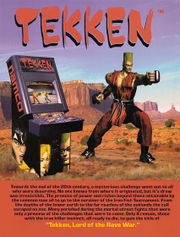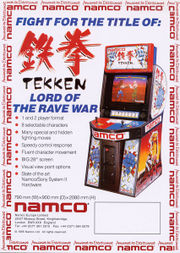Lost In Translation/Tekken
| Tekken | |
|---|---|
| Manufacturer | Namco |
| Released | 1994 |
| Control Method |
8-way Joystick 4 Button(s) |
| Main CPU | PlayStation PSX CPU (@ 16.934 MHz) M37702 (@ 16.384 MHz) |
| Sound CPU | Stereo C352 (@ 16.384 MHz) |
| Video Details |
Raster (Horizontal) 640 x 480 pixels 60.00 Hz 65,536 Palette colours |
| Screens | 1 |
| ROM Info | 13 ROMs 19,660,800 bytes (18.75 MiB) |
| MAME ID | tekken · tekkena · tekkenb · tekkenc |
About The Game
Tekken is a 3-D, one-on-one fighting arcade video game.
World's 8 best martial artists emerge into 'The King Of Iron Fist Tournament' for winning the title of King of Iron Fist and a large purse of prize money. Every artist will try his best to defeat Heihachi and win the prize money and fame.
Additional Technical Information
Players : 2
Control : 8-way joystick
Buttons : 4
=> [1] LP, [2] RP, [3] LK, [4] RK
Trivia
Released in December 1994.
The title of this game translates from Japanese as 'Iron Fist'.
The game was originally going to be called 'Rave War'.
The music in Tekken was recycled in "Tekken 2" for all except Venezia and the Character Select BGM. Marine Stadium -> Bruce, Monument Valley -> Armor King, Angkor Wat -> Kunimitsu, Fiji -> Roger, Windermere -> P.Jack, Acropolis -> Kuma, Chicago -> Lee, Szechwan -> Wang, Kyoto -> Ganryu, King George Island -> Anna.
Some of the characters' sound effects are recycled for other characters :
- Kazuya and Lee
- Yoshimitsu and Kunimitsu
- Nina and Anna
- Jack, P.Jack, Ganryu and Heihachi
- King, Armor King and Kuma
- Law, Paul, Michelle and Wang have their own individual sounds.
Interestingly, Kunimitsu had Yoshimitsu's voice, although Kunimitsu is a female character. Why Namco decided not to use Michelle's or Nina's voices no-one knows.
Law was originally going to be called 'Dragon'. This name remained on his PL1 outfit. In the sound ROM, the announcer says 'Law the Dragon', but this was cut to just say 'Law' afterwards. This is why the announcer's voice sounds cut off mid-sentence.
The boss characters mostly share the same moves as the 8 playable characters, with more moves added (e.g. Heihachi gains the 'Hammer to Power Punch' from Paul). While the boss characters share the same moves as the regular characters, they are also given extra moves for extra difficulty.
Similarity of the boss characters :
- Heihachi : Kazuya
- P.Jack : Jack
- Ganryu : Jack
- Kuma : Jack
- Lee : Law
- Anna : Nina
- Wang : Michelle
- Armor King : King
- Kunimitsu : Yoshimitsu
Paul was never 'cloned' by any character.
Heihachi was given Paul's 'Hammer to Power Punch' & 'Heavy Power Punch' (a.k.a. Deathfist, a fan name).
P.Jack was given Paul's 'Hammer to Power Punch'.
Kuma was given Michelle's 'G-Clef Cannon'.
Wang was given Paul's 'Heavy Power Punch'.
Armor King was given Kazuya's 'Rising Uppercut' & 'Dragon Uppercut'.
Anna was given Law's 'Crescent Kick'.
Lee was given Paul's 'Double Hop Kick' combos and Kazuya's 'Left Splits Kick'.
Ganryu received the only hidden (non-playable) moves of the game - left and right handed versions of the 'Palm Combo'. Players would find this move later in "Tekken 2".
Kunimitsu remained unchanged and shared every Yoshimitsu move (however the CPU never used the sword moves or the 10-hit combo against a player).
Tekken / Namco Game Sound Express Vol.17 [Victor Entertainment - VICL-15039 - Mar 24, 1995]
Updates
- REVISION 2
- Software version : TE1/VER.B (Japan)
- Software version : TE2/VER.B (World)
- Build date : 17:53:08, DEC 9 1994
- REVISION 3
- Software version : TE2/VER.C (World)
- Software version : TE4/VER.C
- Build date : 15:07:12, JAN 12 1995
- REVISION 4
- Software version : TE5/VER.A
- Build date : 22:16:57, MAR 23 1995
Tips and tricks
- If you attempt to throw an opponent but it doesn't connect properly, the opponent will yell in a hurt manner. This can be done if you're slightly out of range (only just connect but miss), if the opponent is in the air, and also if they have their back turned. It's funny when you perform this against Yoshimitsu, as he will say 'Ow!' even though he wasn't hurt in any way!
- The slowest recovering move in the game is Jack's 'Body Press'. If Jack doesn't fully connect with the opponent, he will fall over and automatically stagger backwards, leaving himself open to lots of attacks. On the other side, if you happen to be crushed by Jack, you will be stuck on the ground for an even longer time.
- The most powerful move in the game is Jack's 'Gigaton Punch', at 128 damage points and an instant KO. The player must wind up by rotating the stick 5 times, with the announcer counting, and press Left Punch to complete the move. Failure to do so will leave Jack winding his arm for a short while and you can't move or block until he powers back down. Left Punch can be pushed during any wind-up but will do less damage the shorter the wind-up is.
- Nina has a special throw called the 'Back Hand Slap'. This unique throw can be linked to more damaging moves, in the form of an unblockable combo. Anna (CPU) has a toned down version of the same move with only one follow-up (Arm Snap): -
- Back Hand Slap : In a quarter circle motion roll the stick D,DF,F and press LP+RP to initiate the throw. This throw is not very damaging and is the only throw to leave the opponent still standing. On its own it does 15 damage.
- Arm Break : Right after grabbing the opponent with the above move, quickly press LP,LK,RP,LP. Nina will grab her opponent's arm and bend it backwards. 20 damage (total 35).
- Double Arm Break : If you thought breaking one arm was enough, the 'Silent Assassin' will turn around again and break both her opponents arms at the same time. This is done right after the animation changes to 'Arm Break' by pressing LK,LP,RK,LP+RP,LP+RP in the short amount of time. 25 damage (total 60).
- Falling Arm Break : An alternative combo to the Arm Break. Nina will instead fall on top of her opponent's broken arm causing more damage. This is done right after the animation changes to 'Arm Break' by pressing RP,LP,LK,RK,LP+RP in the short amount of time. 25 damage (total 60).
- Arm Snap : Another Back Hand Slap follow-up. Right after grabbing the opponent with the first move, quickly press LK,RK,LK,LP+RP. Nina will wrestle her opponent to the ground and break their arm. 30 damage (total 45).
- Michelle is the only character in Tekken to have a back throw; a special throw which would be available to all characters as of "Tekken 2" and later. Wang (CPU character on stage 8) also has this throw. If you are caught in this move, hold Down to duck the throw.
Spin Behind to Behind Back Suplex: Press Back+RP (spin on hit), then hold LP+RP to initiate back throw. 12+45 damage (total 57).
- Some moves are not blockable if done in sequence : King's 'Exploder' and 'Running Exploder' can be followed up to a rising kick, as can Nina's 'Forward Flip Kick'. The rolling cross chop (all character except Jack) from the ground also has a similar property if a simple left or right punch is made. You can do basic juggle moves (air combos) from this feature.
- 10-Hit Combos (buttons : LP=1, RP=2, LK=3, RK=4) : These must be timed so each move corresponds with each hit (or, take advantage of the 'feature' which lets all buttons pressed at once count as each hit after the first). This was fixed in the PlayStation version and later games: -
- Yoshimitsu : 1,2,1,4,4,4,1,1,1,1
- Nina : 1,2,1,2,3,3,2,1,2,4 (alt : d/f+1,2,1,2,3,3,2,1,2,4, alt.2 : f+2,1,2,3,3,2,1,2,4)
- Law : d/f+1,2,2,1,3,3,3,4,3,4
- Paul : 1,2,3,1,4,1,2,4,2,1
- Kazuya : f,f+2,1,2,2,3,4,4,1,2,1
- Jack : d+2,1,1,1,2,1,2,1,1+2,1+2 (quick press down+2 to start)
- King : 1,2,1,1,2,4,4,4,1,3 (alt : f+2,1,2,2,4,4,4,1,3)
- Michelle : 2,1,1,2,3,3,3,4,4,1
Series
- Tekken (1994)
- Tekken 2 (1995)
- Tekken 3 (1996)
- Tekken Tag Tournament (1999)
- Tekken 4 (2001)
- Tekken Advance (2001, Nintendo Game Boy Advance)
- Tekken 5 (2004)
- Tekken 5 Dark Resurrection (2005)
- Tekken 6 (2007)
Staff
- Director & Main Designer
- Seiichi Ishii
- Coordinator
- Masamichi Abe
- Game Maintenance
- Teruaki Konishi
- Masahiro Kimoto
- Yutaka Kounoe
- Design Supervisor
- Satoru Yamada
- Character Designers
- Kunihiko Nakata
- Masanori Kimura
- Yoshihisa Yaguchi
- Kenichi Isozaki
- Motion Designers
- Hitoshi Matsuda
- Masahiro Onoguchi
- Shigeo Sasaki
- Kaname Takai
- Tetsuya Okamoto
- Visual Designer
- Hiroko Ohnishi
- Logo & Graphic Designer
- Hideaki Ito
- Program Supervisor
- Katsuo Nakamura
- Main Programmer
- Masanori Yamada
- Game Programmer
- Naoki Ito
- System Programmer
- Yoshihito Saito
- Stage & Effects Programmer
- Toshihiro Itou
- Motion Picture & Enemy Programmer
- Kiyomi Moriya
- Management Of VRAM
- Tetsuya Funatsu
- Model Convert Programmer
- Norimasa Matsuura
- Tool Support
- Kazuyuki Nikaido
- Naoto Hanai
- Test Mode Programmer
- Takayasu Yanagihara
- Sound Designers
- Yoshie Takayanagi
- Yoshie Arakawa
- Kazuhiro Nakamura
- Producer
- Hajime Nakatani
- Voice
- Alex Easley
- Ginga Banjou (Heihachi)
- Lisa Hart
- Robb Satterwhite
- Lynn Harris (Nina Williams)
Cabinet and Artwork
Ports
- Consoles
- Sony PlayStation (1995)
- Sony PlayStation 2 (2005, "Tekken 5 Ultimate Collectors Edition")
- Sony PlayStation 2 (2005, "NamCollection") (Japan only)
- Sony Playstation 2 (2005, "Tekken 5")
Soundtrack Releases
| Album Name | Catalogue No. | Released | Publisher | Comments |
|---|---|---|---|---|
| Namco Game Sound Express VOL.17 Tekken | VICL-15039[1] | 1995-03-24 | Victor Entertainment, Inc. | CD version. |
| Tekken Drama CD | SRCL-4193[2] | 1998-02-21 | Sony Music Entertainment (Japan) Inc. | CD version. |
| Tekken U.K. Remixes | VICL-23120[3] | 1996-09-28 | Victor Entertainment Inc. | CD version. |
| Tekken (UK) | JVC-9003-2[4] | 1996-04-10 | JVC | CD version. |
| TEKKEN - Windermere: The Jungle Mixes | JVCD-0002-1[5] | 1996-04-21 | JVC | CD version. |
| TEKKEN - Windermere: The Jungle Mixes (Vinyl) | JVCD-0001-6[6] | 1995-02-25 | JVC | Vinyl version. |
References
- ↑ Namco Game Sound Express VOL.17 Tekken (CD) at the VGMdb
- ↑ Tekken Drama CD (CD) at the VGMdb
- ↑ Tekken U.K. Remixes (CD) at the VGMdb
- ↑ Tekken (UK) (CD) at the VGMdb
- ↑ TEKKEN - Windermere: The Jungle Mixes (CD) at the VGMdb
- ↑ TEKKEN - Windermere: The Jungle Mixes (Vinyl) at the VGMdb








